Magento 2 Backend Exploration: Products
We’ve already described core sections of Admin->Sales (Orders, Invoices, Credit Memos, etc.) and want to draw your attention to the Catalog section of the Magento 2 backend. In the following article, you will discover a detailed description of the Products screen. Besides, we shed light on how to add new products, as well as import and export them. This tutorial suits both Magento 2 Commerce and Open Source users.

Table of contents
- 1 Magento 2 Products Screen
- 2 Magento 2 Product View
- 3 How to Create a New Product in Magento 2
- 4 How to Import Products to Magento 2
- 5 How to Export Products from Magento 2
- 6 Improved Import & Export Features
- 7 Final Words
Magento 2 Products Screen
You can find the Products screen under Catalog-> Products.

Control Elements
The Products screen offers numerous standard control elements common to the Magento 2 admin.
You have a search field on the top left above the grid. A dropdown with actions is available below. You can apply the following commands to multiple products in bulk:
- Delete;
- Change status;
- Update attributes;
- Assign Inventory Source;
- Unassign Inventory Source;
- Transfer Inventory To Source.
You can use the search field to find products using different parameters. Just type a query and hit the Enter button.
To apply mass actions to products in Magento 2, select items from the grid – tick them in the first column manually (you can also choose Select All, Deselect All, Select All on This Page, or Deselect All on This Page from the dropdown in the first column) – and select an action you want to apply from the Actions dropdown:
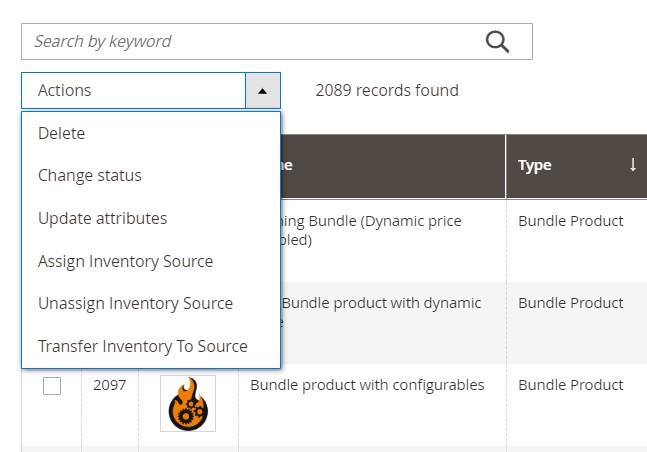
The top right area above the Products grid lets you apply filters, switch between grid views, show/hide columns, select the number of orders per page, and switch between grid pages.
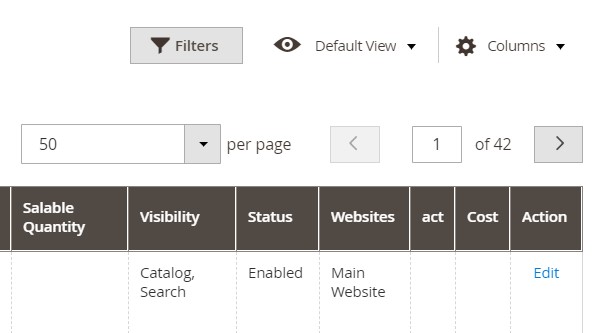
Below, you can see the section with filters. It lets you narrow down the selection of products in the grid by specifying such parameters as:
- ID;
- Price;
- Cost;
- Store View;
- Name;
- Type: Simple, Virtual, Bundle, Downloadable, Configurable, Grouped Product
- Attribute Set;
- SKU;
- Visibility: Not Visible Individually; Catalog; Search; Catalog, Search;
- Status: Enabled, Disabled.

At the same time, the Magento 2 admin lets you customize the appearance of the Products grid by showing/hiding almost 40 different columns. Of course, more than three dozens are too much, but you can select ones that suit your business needs!
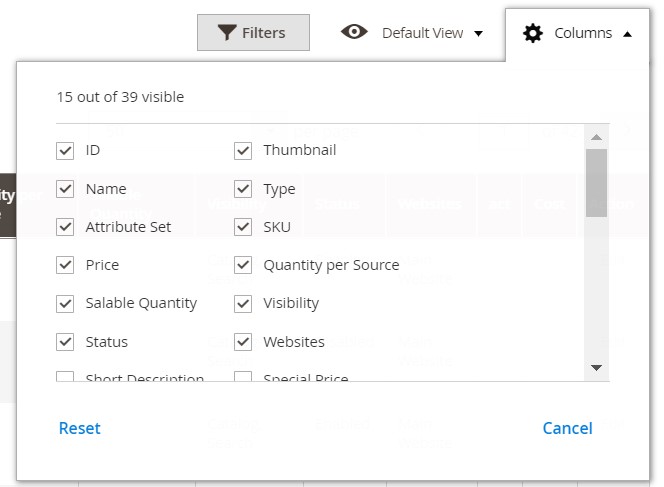
After changing the appearance of the Products grid, you can save it as a new view:
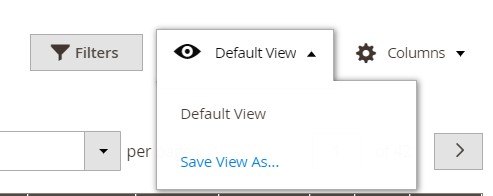
The Default Products Grid View
The default Products grid view in our demo includes the following columns:
- Checkboxes – select products for mass actions;
- ID – a product ID;
- Thumbnail – a small image of a product;
- Name – a product name;
- Type – Simple, Virtual, Bundle, Downloadable, Configurable, Grouped Product;
- Attribute Set – an attribute set name;
- SKU – a product SKU;
- Price – a product price;
- Salable Quantity – whether a product from a specified stock is salable and the available quantity;
- Visibility – Not Visible Individually; Catalog; Search; Catalog, Search;
- Status – Enabled or Disabled;
- Websites – sites a product is displayed on;
- Cost – the actual price of a product;
- Action – view and edit a product.
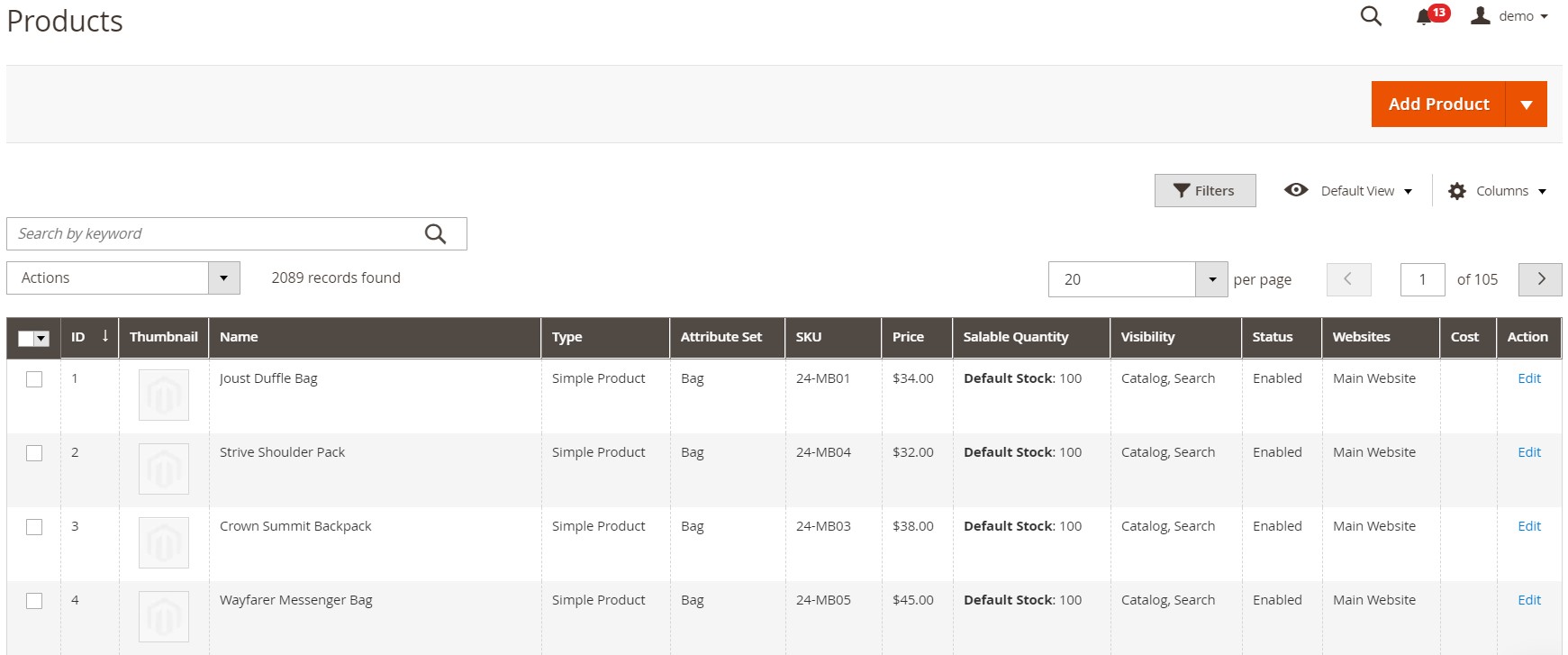
Magento 2 Product View
While editing a product, you can enable/disable it and select an attribute set. Next, it is possible to write a product name, SKU, and price. Another option lets you choose a tax class. If necessary, you can specify product weight. Adding categories is the next option. And the Magento 2 admin lets you choose visibility options.
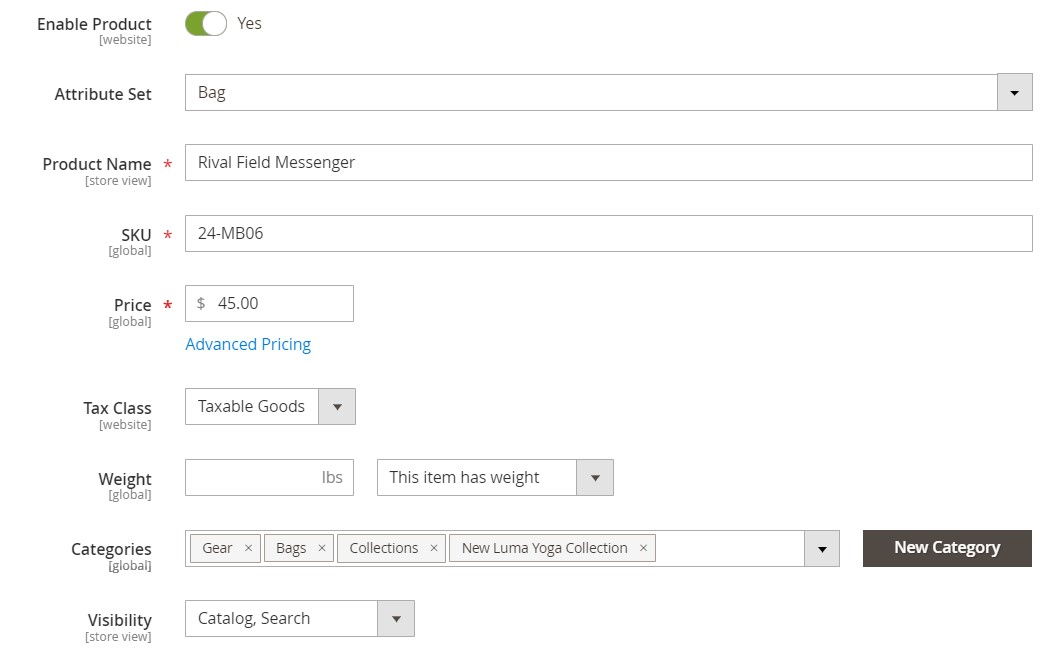
You can also set the product as new for specific dates and specify a country of manufacturer. Next, you can select such parameters as Activity, Style Bags, Material, Color, Strap/Handle, Features, etc. They depend on the selected attribute set.
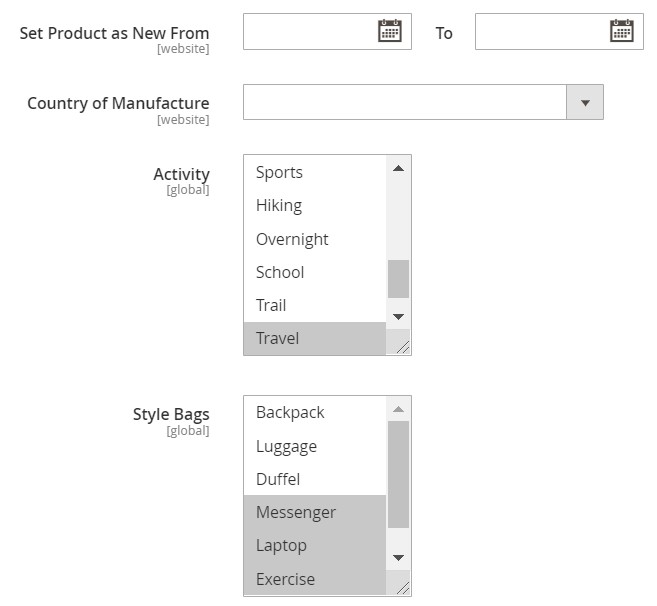
After that, you can proceed to the Sources tab to assign warehouses to the product and specify the available quantity.
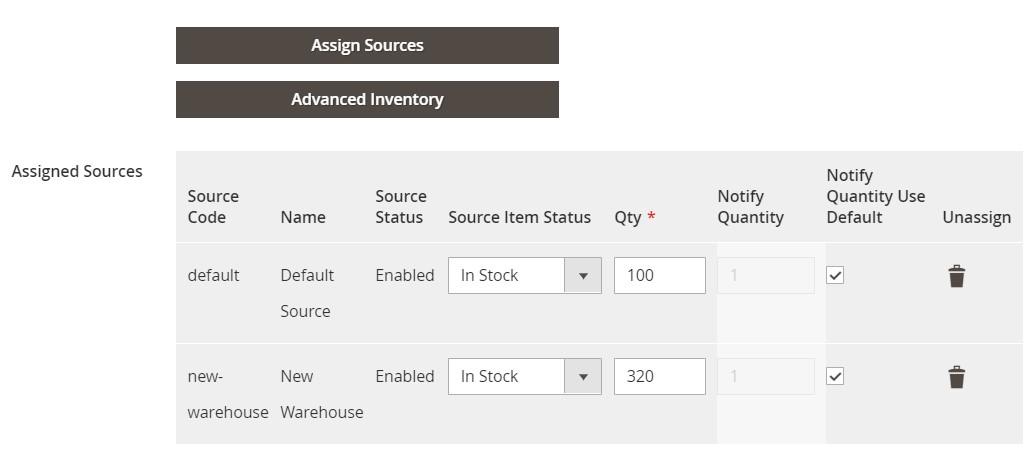
On the Content tab, add full and short product descriptions.

In Configurations, you can turn a simple product into a configurable one.

The Product Reviews section provides the ability to view and edit comments.
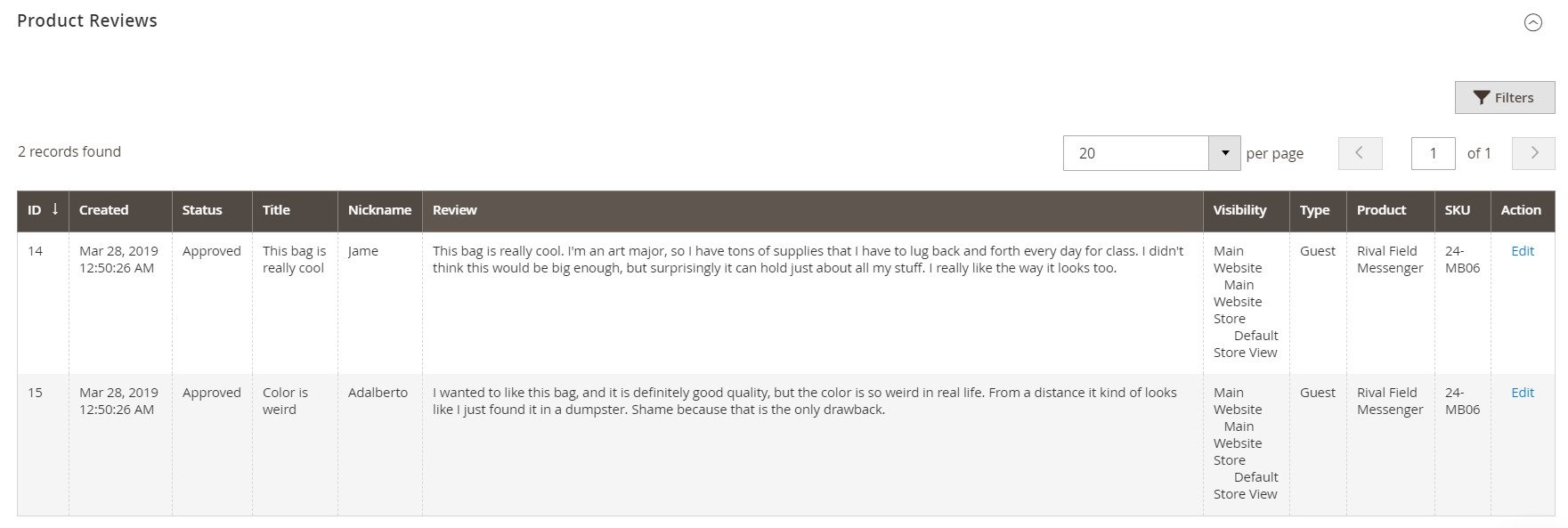
In Images And Videos, you can add the corresponding visual content to a product page.

The SEO section lets you specify a product page URL key and meta title, keywords, description. The last one is limited to 255 characters.

In Related Products, Up-Sells, and Cross-Sells, you can add products to the corresponding product page sections. It is also possible to remove already assigned items.

Customizable options offer customers a selection of options with a variety of text, selection, and date input types. If you have numerous products with the same options, set up one product, and import the options to the others in this section.

There is also a section where you can show/hide the product on different websites.

You can view product sellable quantity on a separate tab as well.

New design patterns, including a page layout, the position of product options, and XML layout update can be configured from a product view page on the Design tab.

If you want to create a specific page look for a particular occasion, use the Schedule Design Update tab. It lets you specify a period the changed appearance is visible and select a new theme and layout for it.

In Gift Options, you can enable/disable gift messages.

The Downloadable Information tab is dedicated to downloadable products. You can enable it by setting the product weight to “no.”

How to Create a New Product in Magento 2
To create a new product in Magento 2, return to the Products grid and hit an arrow sign on the right part of the Add Product button. You will see a selection of the following options:

Select the type of product you want to add. You will be redirected to a screen similar to the one we’ve described above. You have to specify everything from scratch here, not like on the default product view screen.
How to Import Products to Magento 2
To import 10,000+ products to Magento 2 very quickly and in a fully automated way, we recommend you to use the Improved Import & Export Magento 2 extension. This module not only dramatically simplifies and enhances the default product import process but also lets you transfer all the related data from any external system. Let’s imagine that you are migrating from your old Magento 1 website to a brand new Magento 2 store. Create an export file with products on your old site. Next, transfer it to a server or a dropbox account. Then, follow these steps:
Go to System->Improved Import/Export->Import Jobs and hit the “Add New Job” button.
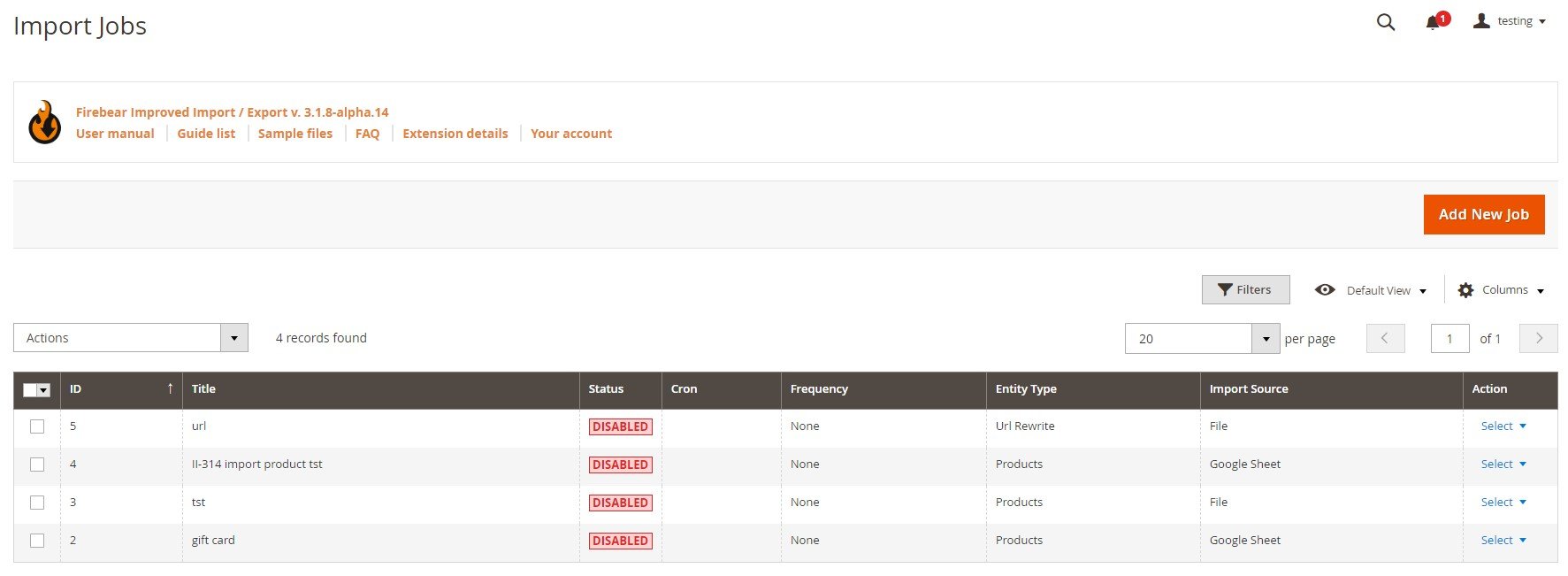
In General Settings, enable the job, specify its title, choose the manual run frequency (we are transferring data from your old store, so it is a one-time procedure), select a language (locale), and enable/disable the following features depending on your business needs:
- Generate Unique Url if Duplicate;
- Re-Index after Import;
- Send email from new tracks.
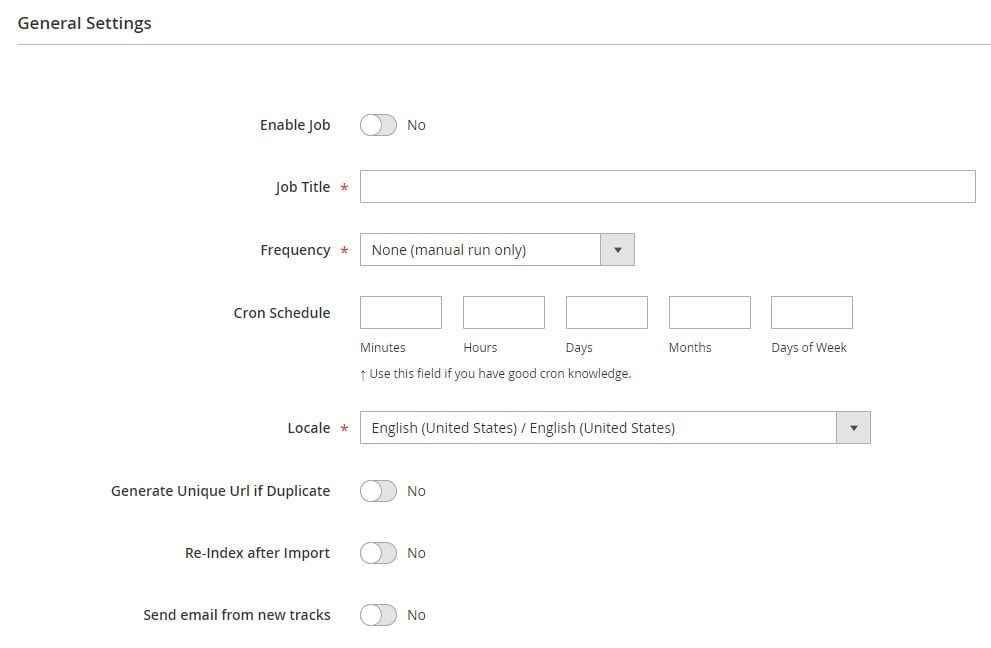
In Import Settings, disable API (if you are going to transfer products via CSV from your old Magento 1 website), choose Products in the Entity dropdown, and select a platform (Magento 1). You can also enable/disable the following parameters:
- Clear Attribute Values – empty/deselect values for ALL optional attributes you are importing;
- Remove Product Association – remove Product Association (supported Grouped);
- Remove Product Website – remove old Websites assigned to products;
- Remove Product Categories – remove old Categories assigned to Product;
- Remove All Images – remove all existing image allocations from db (not from the directory);
- Remove Related Products – replace old related products by new ones from the import file.
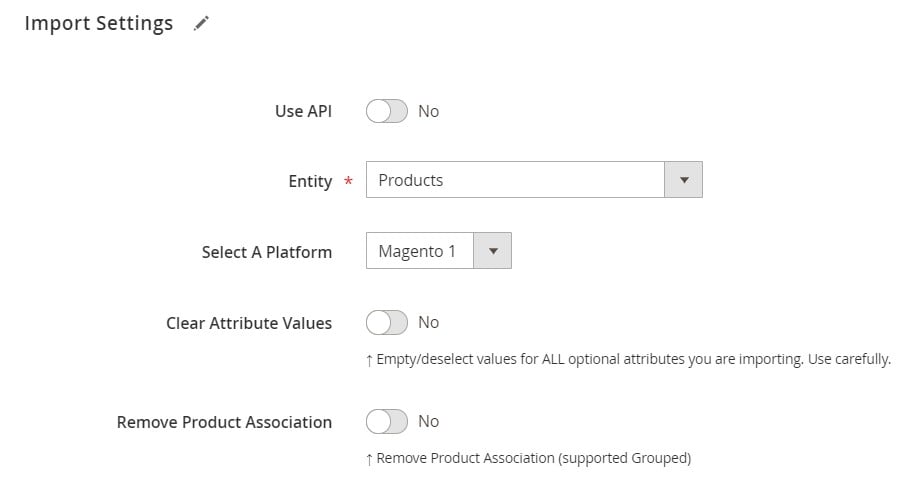
In Import Behavior, select Add/Update from the dropdown, choose a validation strategy, specify the maximum possible number of errors, and type separators.
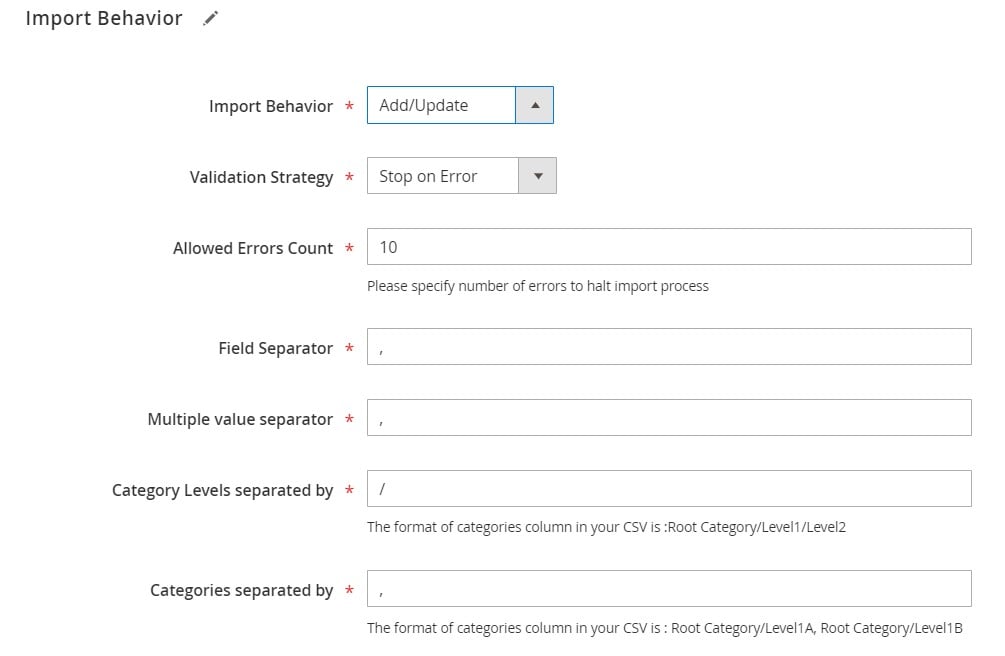
In Import Source, select CSV as your import file type (or choose another standard if your data file is not CSV). Next, specify your import source. You can import a data file with products to Magento 2 from a server, Dropbox account, URL, or upload it directly. In the case of Dropbox, specify a file path, access token, and remote images directory. Enable/disable the following features depending on your business needs:
- Use Image Import Source;
- Do you want to remove current mappings?
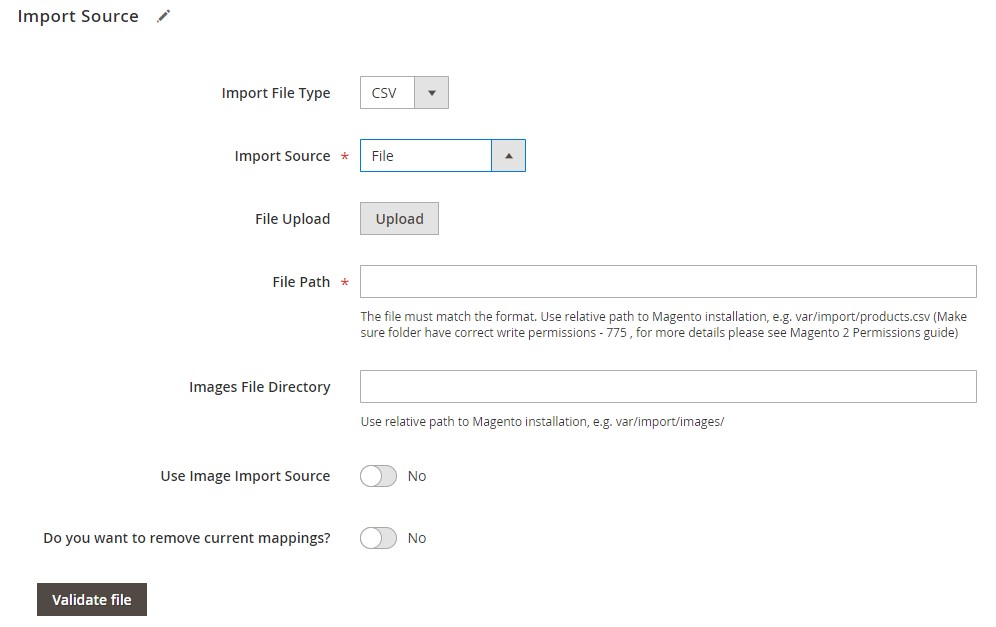
To start the product import process, hit “Save & Run” in the top right corner of the screen. For further information about product import in Magento 2, follow the link below and contact our support:
Get Improved Import & Export Magento 2 Extension
How to Export Products from Magento 2
To export products from Magento 2, we recommend you to use the Improved Import & Export Magento 2 extension as well. This module not only automates the default product export but also lets you transfer all the related data to any external system without modifying anything manually. Let’s imagine that you need to provide an ERP system with products daily. Follow these steps to achieve your goal:
Go to System->Improved Import/Export->Export Jobs and hit the “Add New Job” button.
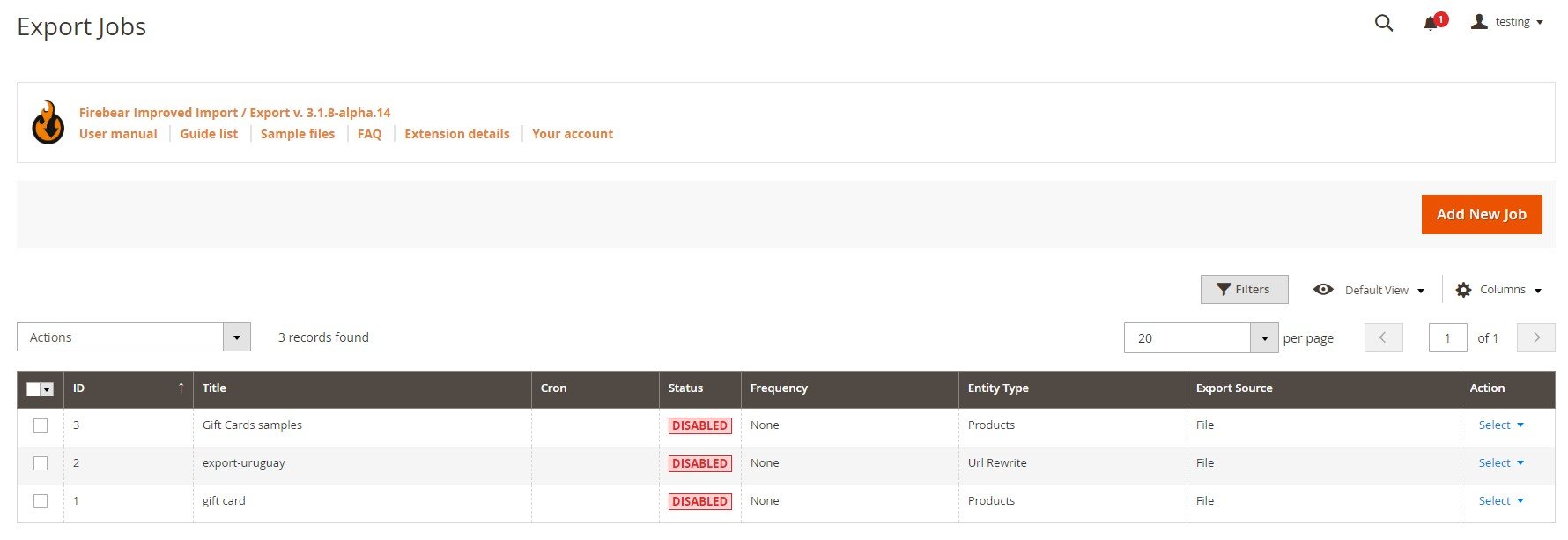
The General Settings section lets you enable the job, type its title, and select a frequency (every day at 3:00 am). Choose a local file language and divide additional attributes if necessary.
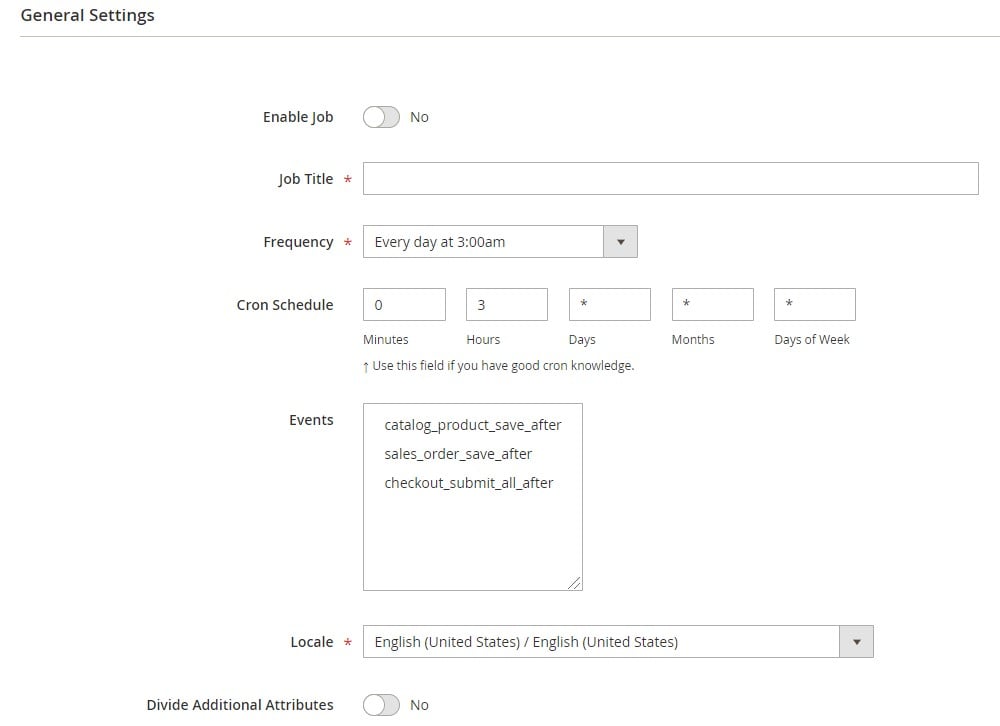
In Export Settings, select Products from the Entity dropdown and enable Consecutive Export.
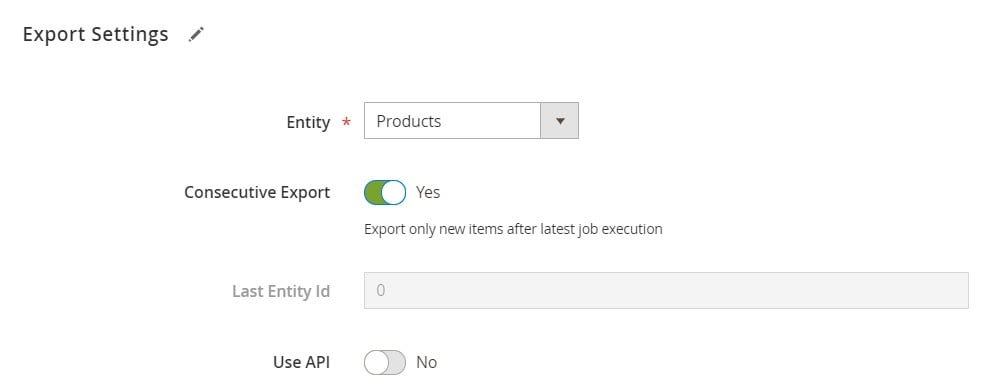
In the Store Filter section, select store views to export products from.

In Export Behavior, select a format of your product export file (your ERP system should support this format) and specify separators.

In Export source, specify where your products should be transferred to. You can select FTP, SFTP, or a data file as a destination. Check the connection before going any further.

Next, you can map attributes and add filters.
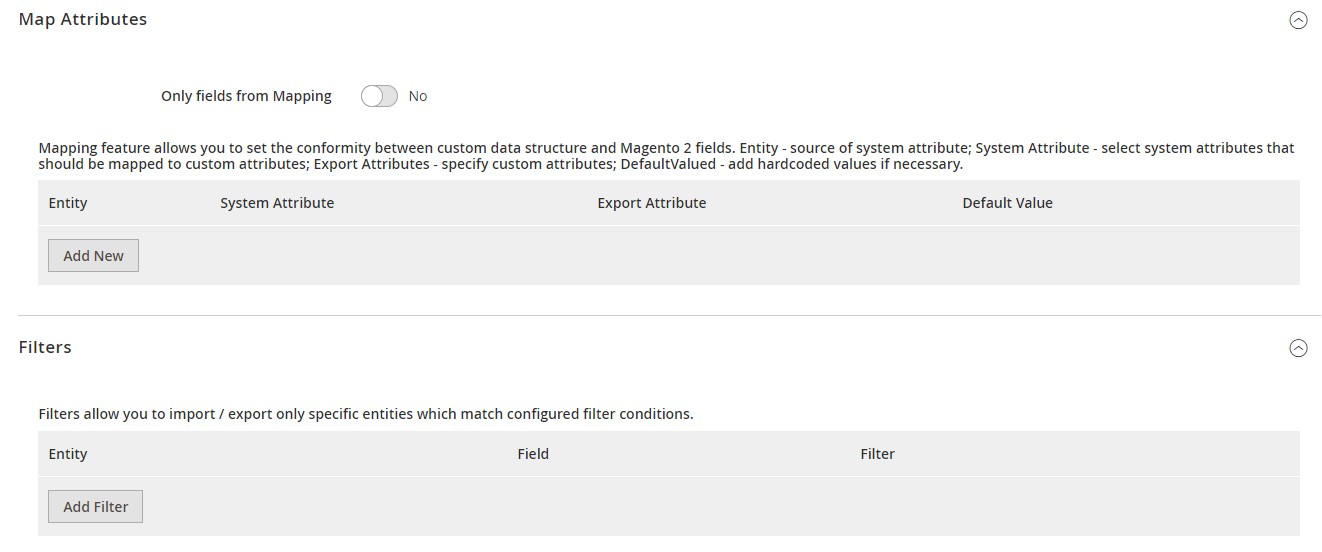
To start the export process, hit “Save & Run” in the top right corner of the screen. For further information about product export in Magento 2, follow the link below and contact our support:
Get Improved Import & Export Magento 2 Extension
Also, check this guide: The Complete Guide to Magento 2 Product Import / Export.
Improved Import & Export Features

Now, let’s pay a little bit more attention to the features of the Improved Import & Export extension that simplify product import to Magento 2 as well as other data transfers. The tool is designed to turn your Magento 2 admin into a central hub where you control all integrations. The default transfer tools of Magento 2 Commerce don’t offer anything similar.
What makes Improved Import & Export unique? The extension provides several ways of moving products and the related data to and from your e-commerce website, including a direct connection between the two systems. As an admin, you can manage all integrations right in the backend interface, automating all product import and export processes. Let’s start the exploration describing this opportunity.
Automated Import & Export Processes
The Improved Import & Export Magento 2 extension provides two ways of automatic product data import and export: schedules and event-based triggers. We describe both mechanisms below. Let’s take a look at how schedules work.
Schedules
With the Improved Import & Export Magento 2 extension, you can use the default cron syntax to create import/export schedules moving Magento 2 products to/from a remote platform. The module provides the ability to specify any custom intervals so that you can create a schedule suitable for your specific business needs. At the same time, you can select one of the predefined intervals, which are also fully customizable, create import and export profiles that have no schedules, or launch every profile manually.

Events
Event-based triggers represent the second way of automating data transfers in Magento 2. The Improved Import & Export extension enables real-time updates based on them. Create and configure a trigger specifying conditions to synchronize two systems right after a specific action takes place.
With event-based triggers, you can select an event that launches the product data transfer. The plugin considers the specified event a trigger and starts product export right after. Thus, the data is provided to a remote platform in real-time.
The same approach can be applied to import processes as well. For further information, check this article: How to Run Magento 2 Import or Export After Specific System Event or Process.
Advanced Mapping Features
Below, you can find another essential aspect of the Improved Import & Export Magento 2 extension – the ability to solve problems caused by different attribute standards. Our module provides several exclusive mapping features that dramatically simplify both import and export procedures.
It eliminates the necessity to edit attributes and their values manually in a data file. If exporting product data with Magento 2 attributes won’t interrupt the transfer, it may cause multiple headaches when you try to provide the file to an external system. That’s why mapping may save lots of time and effort.
Besides, our extension offers handy tools for matching attribute values and even categories as well as generating missing elements of a data file right during the import. Once configured, a mapping scheme is saved and utilized for further updates so that you can automate products import/export entirely.
Mapping Presets
With the Improved Import & Export Magento 2 extension, you get a very straightforward way of matching external attributes to ones used internally – mapping presets. Predefined mapping schemes provide the ability to implement attribute matching in a few clicks. While configuring a new job, choose a suitable preset and let the Improved Import & Export Magento 2 extension do all the work for you.
Instead of figuring out what third-party attributes are utilized in your file with products, you let our module analyze the input data and match all third-party designations to the internal ones. Any manual interactions with data files are eliminated. Here is how everything happens in the admin:

Matching Interface
If there is no preset suitable for your integration or you want to make an import/export file suitable for third-party requirements manually, utilize the matching interface of the Improved Import & Export Magento 2 extension. It lets you map attributes in the Magento 2 backend. The procedure is fast and intuitive: select an entity, choose a system attribute, and specify the corresponding external one in front of it as shown below:
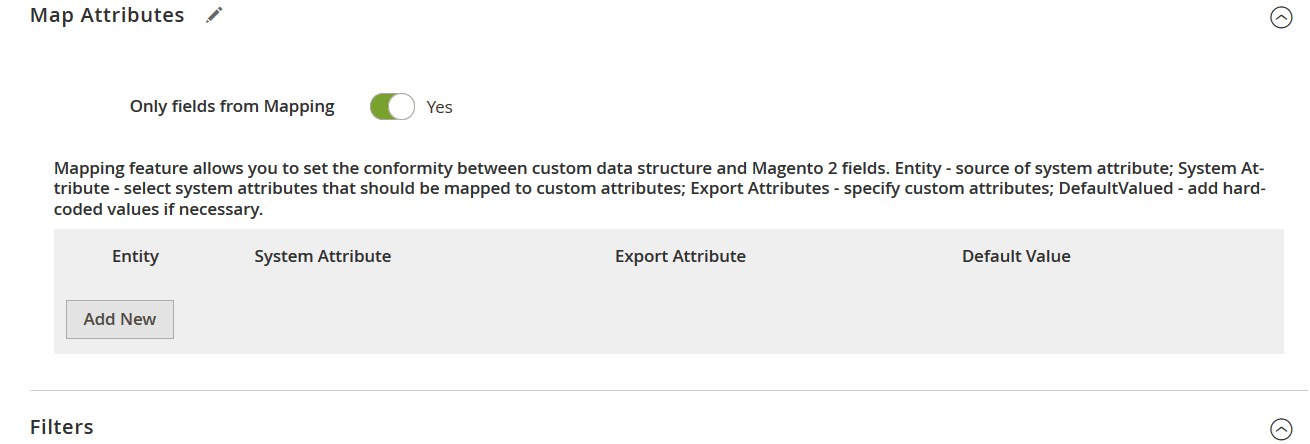
As for the “Default Value” column, it lets you specify hardcoded (default) attribute values. If you import products from multiple store views to a single on, this feature saves tons of time.
Filters
Now, when you know how to map attributes and use hardcoded values, we’d like to describe another feature that lets you export Magento 2 products – filters. Follow these steps to master the tool:
- Click the ‘Add Filter’ button;
- Select an entity;
- Select a system attribute that will be used as a basis of a new filter;
- Specify parameters applied for filtering;
- Repeat the previous steps to create more filters.
Note that parameters applied for filtering vary, depending on the chosen attribute. Everything is intuitive and straightforward:

Attribute Values Mapping
And you can match attribute values with the Improved Import & Export Magento 2 extension as well. Since incorrect values may prevent import processes or may not be accepted by third-party systems, it is essential to replace all unsupported designations with the proper ones. While the default Magento tools don’t let you do that, our plugin offers an interface similar to the one we’ve just described above. Choose a third-party designation and specify a corresponding internal one in front of it while importing products to Magento 2. Repeat matching until no external values are left. For further information, read this article: Attribute Values Mapping.
Attribute Values Editing
You can also edit attribute values in bulk with the help of the Improved Import & Export Magento 2 module. The extension provides the following rules that can be combined and applied to multiple values simultaneously:
- Add a prefix to multiple attribute values;
- Add a suffix to numerous attribute values;
- Split various attribute values;
- Merge multiple attribute values.
Note that the module provides the ability to create various conditions to increase the efficiency of editing. For further information, check this article: How to Modify Attribute Values During Import and Export in Magento 2.
Category Mapping
Another feature of the Improved Import & Export extension that simplifies the way you import products to Magento 2 from any source is category mapping. It lets you import the update without editing third-party categories manually or applying changes after the products are transferred.
Our module lets you match external product categories to ones used internally in a fast and intuitive manner. You apply all the changes in a single place of your admin. The process looks as follows:

It is also possible to create new categories on the fly. The Improved Import & Export Magento 2 module lets you select a parent category and specify a new one related to it. Both features are described here: Category Mapping.
Attributes On The Fly
Another feature that dramatically simplifies product import processes is the ability to create attributes on the fly. If an update file doesn’t include all the necessary data, our plugin allows using the following general form to specify all parameters used to get all missing attributes automatically:
Attribute|attribute_property_name:attribute_property_value|…
The procedure is described in more detail here: Product attributes import.
Extended Connectivity Options
As mentioned above, the Improved Import & Export Magento 2 extension allows extending the default opportunities related to product data transfers. It not only supports remote servers but also offers a bunch of other extended connectivity options.
Multiple File Standards
CSV files are the only standard supported by Magento, and you are no longer limited to it. The Improved Import & Export Magento 2 extension lets you use XML, JSON, ODS, and Excel files instead. As you can see, the necessity to convert data files into CSV and vice versa is eliminated! You can always apply all features described above to any of these file types.
Multiple File Sources
And the vital improvement that enables product file import/export is support for multiple sources. The Improved Import & Export Magento 2 extension lets you leverage several different connection options:
- FTP/SFTP. Transfer data files using a local or remote server.
- Dropbox. Use a Dropbox account to establish a connection between the two systems. Alternatively, you can rely on Box, OneDrive, Google Drive, iCloud, and Amazon Drive.
- URL. A direct URL can be used to import a data file as well.
If your product file is compressed, there is no need to extract it before the import. The Improved Import & Export Magento 2 extension will do everything for you!
Alternative Ways of Import & Export
Since the alternative ways of import and export are not represented in Magento 2 by default, you can establish direct API connections with the Improved Import & Export extension only. It provides the ability to leverage REST for the Magento 2 ERP synchronization as well as other APIs if necessary. For instance, it works with SOAP and GraphQL. Note that all API connections support other extension’s features.
Google Sheets, Office 365 Excel, and Zoho Sheet are the supported intermediary services. Use them to transfer product data to Magento 2. The following image shows how to import product data to Magento 2 from Google Sheets:

And of course, the Improved Import & Export extension opens completely new possibilities with support for WSDL and WADL.
The video below displays other details of our extension:
Final Words
Now, you know how to manage products in Magento 2. Neither creating not importing/exporting them is complicated, especially if you use Improved Import & Export for transfers. For further possibilities of our extension, follow the link below and contact our support:
Get Improved Import & Export Magento 2 Extension









